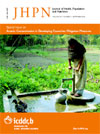
|
The Journal of Health, Population and Nutrition
icddr,b
ISSN: 1606-0997
EISSN: 1606-0997
Vol. 33, No. 2, 2015, pp. 1-7
|
 Bioline Code: hn15031
Bioline Code: hn15031
Full paper language: English
Document type: Research Article
Document available free of charge
|
|
|
The Journal of Health, Population and Nutrition, Vol. 33, No. 2, 2015, pp. 1-7
| en |
From home deliveries to health care facilities: establishing a traditional birth attendant referral program in Kenya
Tomedi, Angelo; Stroud, Sophia R.; Maya, Tania Ruiz; Plaman, Christopher R. & Mwanthi, Mutuku A.
Abstract
Objective: To assess the effectiveness of a traditional birth attendant (TBA) referral program on increasing the
number of deliveries overseen by skilled birth attendants (SBA) in rural Kenyan health facilities before and after the
implementation of a free maternity care policy.
Methods: In a rural region of Kenya, TBAs were recruited to educate pregnant women about the importance of
delivering in healthcare facilities and were offered a stipend for every pregnant woman whom they brought to the
healthcare facility. We evaluated the percentage of prenatal care (PNC) patients who delivered at the intervention
site compared with the percentage of PNC patients who delivered at rural control facilities, before and after the
referral program was implemented, and before and after the Kenya government implemented a policy of free
maternity care. The window period of the study was from July of 2011 through September 2013, with a TBA referral
intervention conducted from March to September 2013.
Results: The absolute increases from the pre-intervention period to the TBA referral intervention period in SBA deliveries
were 5.7 and 24.0 % in the control and intervention groups, respectively (p < 0.001). The absolute increases in SBA delivery
rates from the pre-intervention period to the intervention period before the implementation of the free maternity
care policy were 4.7 and 17.2 % in the control and intervention groups, respectively (p < 0.001). After the policy
implementation the absolute increases from pre-intervention to post-intervention were 1.8 and 11.6 % in the
control and intervention groups, respectively (p < 0.001).
Conclusion: The percentage of SBA deliveries at the intervention health facility significantly increased compared
to control health facilities when TBAs educated women about the need to deliver with a SBA and when TBAs
received a stipend for bringing women to local health facilities to deliver. Furthermore, this TBA referral program
proved to be far more effective in the target region of Kenya than a policy change to provide free obstetric care.
Keywords
Skilled birth attendants; Traditional birth attendants; Midwifery; Maternal health; Kenya; Childbirth; Maternal health services
|
| |
© Copyright 2015 - The Journal of Health, Population and Nutrition
Alternative site location: http://www.jhpn.net
|
|
